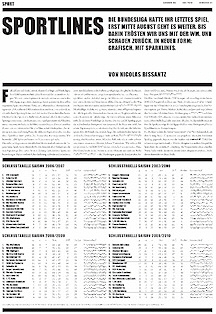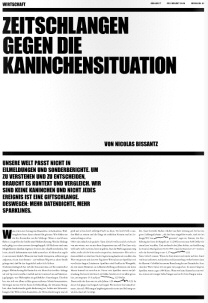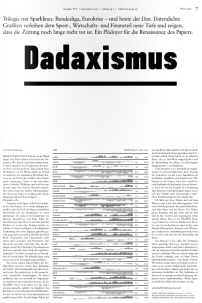Business Intelligence is colorful. Our list of tops and flops for 2010 is just as colorful. In this first, upbeat part, we will show best practices that range from the backdrop of a shooting scene to the most modern business control center today.
In just a few hours, 2010 will be history*. That makes it high time to clear our minds of all of the things that have delighted or disturbed us this year. Some things we haven’t addressed here yet; others deserve to be praised or condemned one more time. We will do this in two parts: first the good, next time the bad. Here are our top best practices in visualization in 2010.
- Recently, we stared in awe while visiting a very large repair shop for electronic devices. In the midst of measuring devices and soldering stations, a young man was practicing operative Business Intelligence – just as we wish it would be done everywhere. For example, he checks the daily updates of cost estimates that didn’t lead to contracts and uses that information to make suggestions for price adjustments or special offers. This way, the company can quickly gain information that a BI application would normally discover much too late and, most importantly, take action. For us, the clear #1 in our top 10 for 2010.
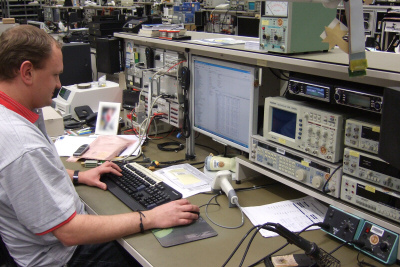
Business Intelligence in day-to-day operations: The team manager analyzes daily what he can learn before the problems grow so big that they become an issue for senior management. - The CFO of a Swiss bank told us that an A3-sized report filled with numbers is printed out for him every morning and is pinned on the wall behind his desk. In the many discussions that he holds each day, questions often emerge that he can quickly answer by simply turning his chair around. To answer questions outside of his office, he keeps a smaller A4 copy of the report tucked in his suit jacket. #2.
- We know of a man who continues to successfully run his mid-size, family-owned business in the fifth generation. This year, his wife gave him a very special Christmas present – Business Intelligence, and that in a form that we will soon talk about here in much more detail. After all, maybe he didn’t have time to unpack it yet. #3.
- Traffic News-to-go printed our sparklines three times on newspaper – probably the first time worldwide in this form. And that was no minor feat. The editing, layout, graphic and print teams all worked up a storm. Together, we proved that newspaper can be both data dense and legible. The data density ranged from 1,200 values, to 5,000 values, to ultimately 10,000 values. The only minor typo crept in came from us. #4.
- Bella authored her first book (in German). It was intended to be beautiful, so we loosened the purse strings – so much, in fact, that all of the publishing companies to which we offered the second edition simply turned us away. Our choice of paper, the preface, the laminated dust jacket, Bella’s paw print as a relief finish, the striking headband, bookmark, thread stitching – everything was simply much too expensive, we were told. We laugh at the thought of penny-pinching with customers and print the second edition – ourselves again. #5.
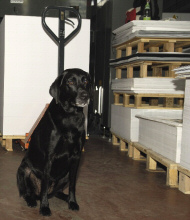
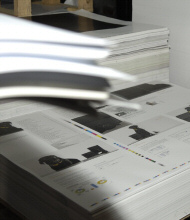
- Again and again we enjoy visualizations in public areas. Mostly you can find your way around cities, highways, or even airports more easily than you can in some reports. Germany may have a large, dense collection of road signs. But at least you can read them and, in most cases, understand them quickly. In New Zealand, however, we discovered the most delightful infographics. All of the miracles of nature are labeled in a tasteful, common design which reduces the exertions of travelling. At the same time, the information culture is fresh, often humorous, and uninhibited. #6.
- For fans of information culture, television is almost a form of self-torture. The cultural programs on ARTE, however, are an enlightening exception. Long live this channel. A recent documentation on the video artist Julian Rosefeldt impressed me in particular. Also, he was asked to set up the backdrop for the shooting scene in the Guggenheim museum for the film “The International”. How we can apply what we learned to BI, we will explain another time. #7.
- The ingenious Irenäus Eibl-Eibesfeldt, a student of Konrad Lorenz, wrote “Weltsprache Kunst” (“World Language: Art”) together with Christa Sütterlin. His masterpiece triggered the feelings of the ultra-correct political class and will point the way to a new era of human communication – in companies as well – to those who will listen. #8.
- The first company who has been fascinated by the idea of an interaction-less ‘ticker portal’ just happens to be our favorite sports car manufacturer – from Germany, of course. The monitors hang in public areas within the company. When a group of people meet up and talk about market and company numbers, it takes us back to a time when not every household had at least one television – and information was supposed to mean seeing instead of searching. #9.
- Hyundai, the only automobile manufacturer which Toyota fears, has hyperaggressively increased its product quality in a very short time and strengthened its market position. According to reports, a great part of this success is due to its unique, real-time business control center. Controlling in German companies resembles the Stone Age in comparison. Hyundai’s two-hundred meter long billboard at the entrance of the Frankfurt Airport is just an omen of the things to come. #10.
Check back soon for the second part of our year in review in this blog.
* I wrote this entry on New Year’s Eve.
